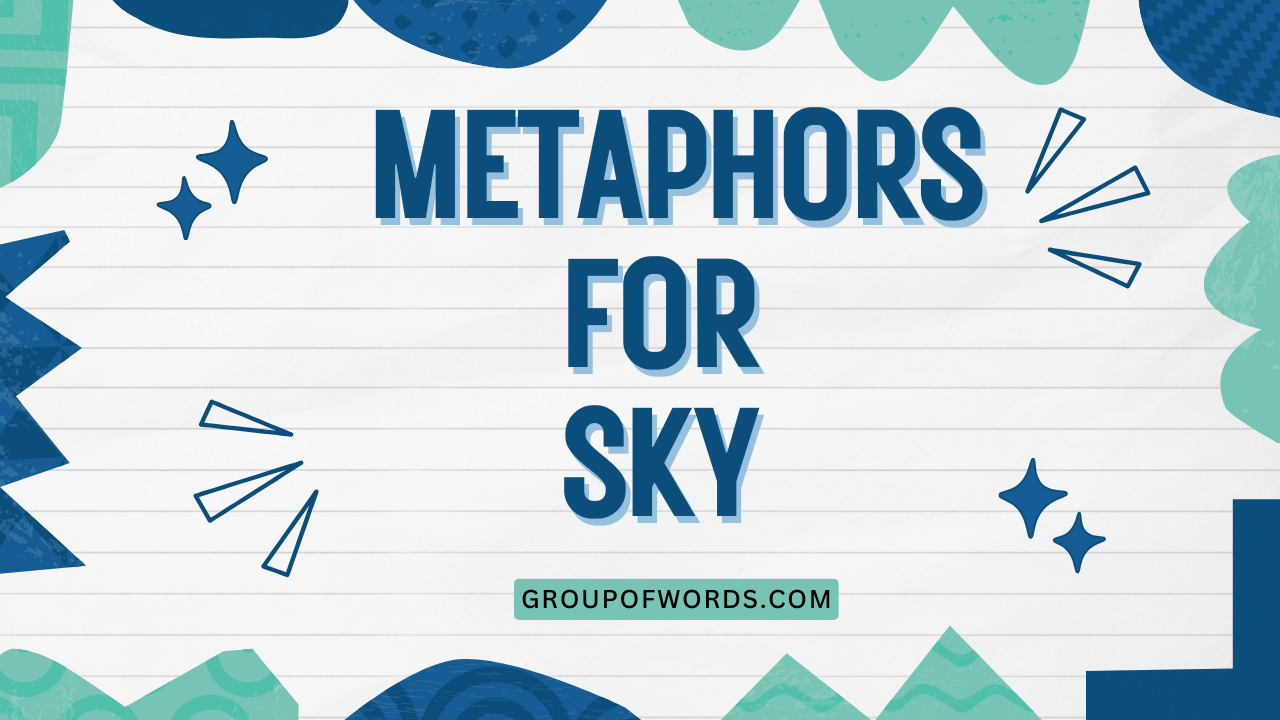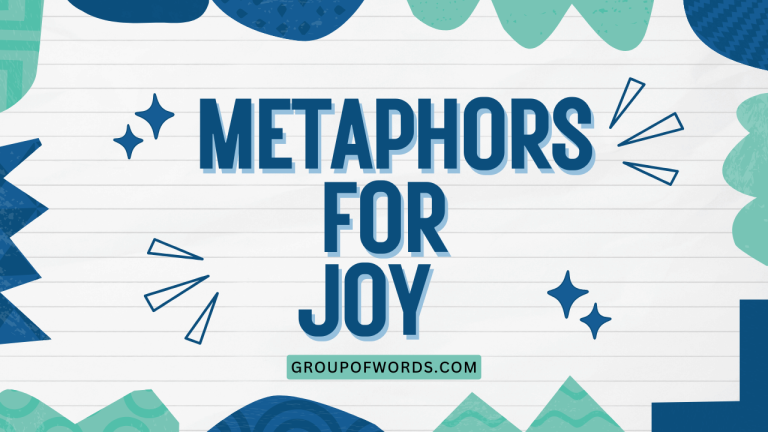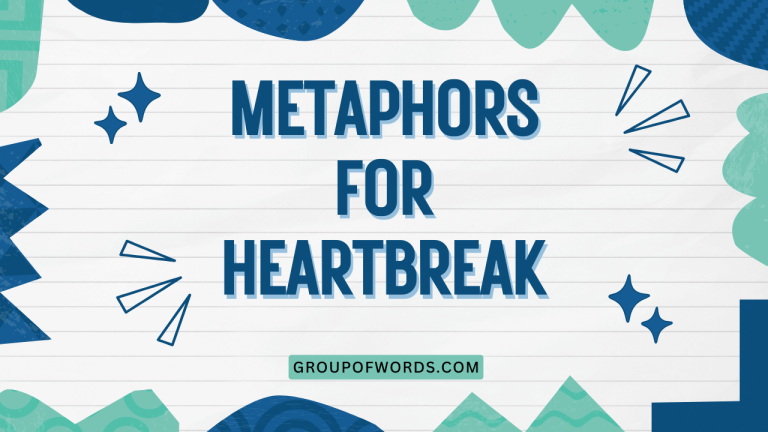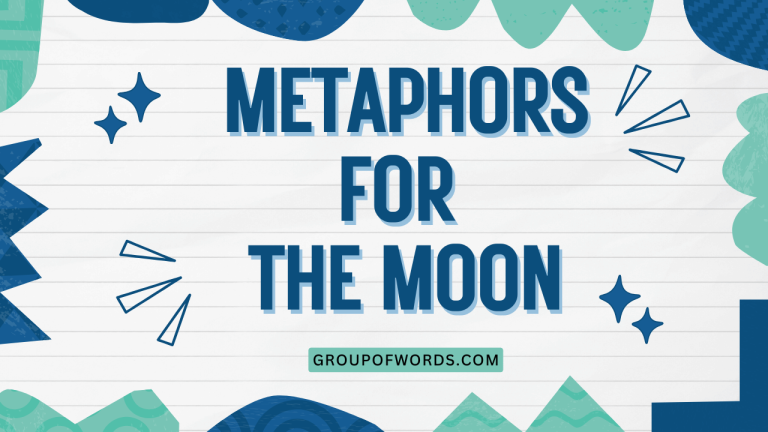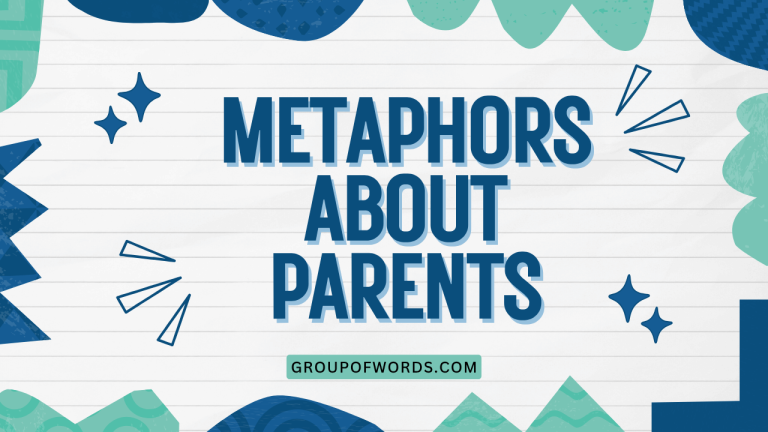Painting the Void: Mastering Metaphors for the Sky
The sky, a constant presence above us, has inspired countless metaphors throughout history. Understanding these metaphors is crucial for appreciating literature, poetry, and even everyday language.
This article delves into the rich world of sky metaphors, exploring their types, structures, and usage. Whether you’re an English language learner, a seasoned writer, or simply curious about the power of language, this comprehensive guide will enhance your understanding and appreciation of this ubiquitous element of our world.
By mastering the art of recognizing and understanding sky metaphors, you’ll not only improve your reading comprehension but also enrich your own writing style. This guide provides numerous examples, detailed explanations, and practical exercises to help you confidently navigate the metaphorical landscape of the sky.
Table of Contents
- Introduction
- Definition of Metaphor
- Definition of Sky Metaphors
- Structural Breakdown of Sky Metaphors
- Types and Categories of Sky Metaphors
- Examples of Sky Metaphors
- Usage Rules for Sky Metaphors
- Common Mistakes with Sky Metaphors
- Practice Exercises
- Advanced Topics: Extended Metaphors and Symbolism
- Frequently Asked Questions
- Conclusion
Definition of Metaphor
A metaphor is a figure of speech that directly compares two unrelated things, asserting that one thing *is* another. Unlike similes, which use “like” or “as” to make a comparison, metaphors create a direct equivalence. This comparison is not literally true but helps to illustrate a shared quality or characteristic, enhancing understanding and creating vivid imagery. The power of a metaphor lies in its ability to transfer meaning from one context to another, offering new perspectives and deeper insights.
Metaphors are fundamental to language and thought, shaping how we perceive and understand the world. They are not merely decorative elements in writing but are integral to how we conceptualize abstract ideas and complex emotions.
By understanding metaphors, we can unlock deeper layers of meaning in communication and literature.
Definition of Sky Metaphors
Sky metaphors are figures of speech that use the sky, or elements related to it (such as clouds, sun, moon, stars, weather), to represent something else. These metaphors leverage the sky’s vastness, beauty, and ever-changing nature to evoke emotions, describe situations, or symbolize abstract concepts. They are often used to depict feelings, ideas, or even the passage of time. The sky’s inherent qualities, such as its color, texture, and atmospheric phenomena, make it a rich source of metaphorical inspiration.
Sky metaphors can be found in various forms of literature, from poetry and prose to song lyrics and everyday conversation. They provide a powerful way to connect abstract ideas with concrete imagery, making complex concepts more accessible and relatable.
The effectiveness of a sky metaphor depends on the audience’s understanding of the sky’s symbolic associations and the context in which the metaphor is used.
Structural Breakdown of Sky Metaphors
The structure of a sky metaphor typically involves two key elements: the tenor and the vehicle. The tenor is the subject being described, while the vehicle is the sky element used to represent it. The effectiveness of the metaphor hinges on the shared characteristics or associations between the tenor and the vehicle.
Let’s break down a few examples to illustrate this structure:
- Example 1: “Her dreams were a limitless sky.”
- Tenor: Her dreams
- Vehicle: Limitless sky
- Shared Characteristic: Boundlessness, potential
- Example 2: “The storm in his heart mirrored the storm in the sky.”
- Tenor: His heart (emotional turmoil)
- Vehicle: Storm in the sky
- Shared Characteristic: Turbulence, intensity, chaos
- Example 3: “His future was a bright, sunny sky.”
- Tenor: His future
- Vehicle: Bright, sunny sky
- Shared Characteristic: Hope, optimism, clarity
Understanding this structural breakdown allows for a deeper appreciation of how sky metaphors function and how they contribute to the overall meaning of a text. By identifying the tenor and vehicle, and analyzing their shared characteristics, we can unlock the layers of meaning embedded within these powerful figures of speech.
Types and Categories of Sky Metaphors
Sky metaphors can be categorized based on the specific elements of the sky they utilize. These categories include color-based, weather-based, emotion-based, object-based, and abstract concept metaphors.
Color-Based Metaphors
Color-based metaphors use the colors of the sky to represent different emotions, moods, or situations. For instance, a “gray sky” might symbolize sadness or depression, while a “blue sky” could represent happiness or tranquility.
These metaphors rely on the commonly associated meanings of colors to convey deeper emotions or ideas.
Weather-Based Metaphors
Weather-based metaphors employ various weather conditions to depict different states of being or events. A “stormy relationship” uses the idea of a storm to represent conflict and turmoil.
Similarly, “calm skies” might symbolize peace and serenity. These metaphors draw on our experiences with weather to communicate complex emotions and situations.
Emotion-Based Metaphors
Emotion-based metaphors directly link the sky to specific emotions. For example, “a sky full of hope” connects the vastness and potential of the sky with the feeling of hope.
“A somber sky” might reflect a feeling of sadness or melancholy. These metaphors create a direct association between the sky and human emotions, amplifying their impact.
Object-Based Metaphors
Object-based metaphors use objects found in the sky, such as the sun, moon, or stars, to represent other things. The “sun of my life” uses the sun to symbolize a source of warmth, energy, and happiness.
“Guiding star” might refer to a person or principle that provides direction and inspiration. These metaphors leverage the symbolic meaning of celestial objects to convey deeper significance.
Abstract Concept Metaphors
Abstract metaphors link the sky to abstract concepts such as time, freedom, or the future. “The sky’s the limit” uses the boundless nature of the sky to represent unlimited potential.
“A clean slate sky” might symbolize a fresh start or new beginning. These metaphors connect the tangible reality of the sky with intangible ideas, making them more accessible and relatable.
Examples of Sky Metaphors
Here are numerous examples of sky metaphors, categorized by type, to further illustrate their diverse applications and meanings.
Color Metaphor Examples
The following table provides examples of color-based sky metaphors. Each example demonstrates how the color of the sky is used to represent a particular emotion, mood, or situation.
| Metaphor | Meaning |
|---|---|
| “A gray sky mirrored her somber mood.” | Sadness, depression |
| “The azure sky reflected the joy in their hearts.” | Happiness, peace |
| “Under a crimson sky, the battle raged on.” | Violence, danger |
| “The golden sky heralded a new beginning.” | Hope, opportunity |
| “The indigo sky whispered secrets of the night.” | Mystery, introspection |
| “A violet sky painted the end of another perfect day.” | Contentment, closure |
| “The silver sky hinted at the promise of rain.” | Anticipation, cleansing |
| “The black sky was a canvas for the stars.” | Darkness, potential |
| “A white sky blanketed the world in snow.” | Purity, stillness |
| “The cerulean sky stretched endlessly above.” | Freedom, vastness |
| “The sky was a muddy brown, reflecting the city’s grime.” | Pollution, desolation |
| “The orange sky burned with the intensity of the sunset.” | Passion, energy |
| “A pale blue sky signaled the arrival of spring.” | Renewal, rebirth |
| “The rosy sky blushed with the first light of dawn.” | Innocence, gentleness |
| “A turquoise sky shimmered above the tropical waters.” | Tranquility, paradise |
| “The leaden sky pressed down with oppressive weight.” | Burden, despair |
| “The sky deepened to a sapphire hue as twilight approached.” | Depth, reflection |
| “A smoky gray sky hung heavy with the threat of storms.” | Danger, uncertainty |
| “The clear azure sky promised a day of adventure.” | Excitement, opportunity |
| “The sky faded to a lavender shade as the day ended.” | Peace, conclusion |
| “The sky was a canvas of teal, reflecting the ocean’s depths.” | Calmness, serenity |
| “The sky was a steel gray, mirroring the coldness of the city.” | Apathy, isolation |
| “The sky turned a vibrant coral color during the sunset.” | Beauty, fleeting moments |
| “The sky was a soft beige, lacking any distinct character.” | Monotony, blandness |
| “The sky was a deep maroon, signaling impending doom.” | Warning, danger |
Weather Metaphor Examples
The following table showcases weather-based sky metaphors, illustrating how different weather conditions associated with the sky can represent various situations and emotions.
| Metaphor | Meaning |
|---|---|
| “Their relationship weathered many storms.” | Challenges, difficulties |
| “After the storm, calm skies returned to their lives.” | Peace, resolution |
| “Her anger was a sudden thunderstorm.” | Intense emotion, outburst |
| “His tears were gentle rain.” | Sadness, cleansing |
| “The fog of doubt clouded his judgment.” | Uncertainty, confusion |
| “A whirlwind of activity surrounded her.” | Chaos, busyness |
| “The drought of inspiration left her unable to write.” | Lack, barrenness |
| “He was a beacon in the stormy sea of life.” | Guidance, hope |
| “The flood of memories overwhelmed her.” | Overwhelming emotion, nostalgia |
| “The gentle breeze of change swept through the town.” | Transformation, renewal |
| “The blizzard of paperwork buried him alive.” | Overwhelm, burden |
| “She was a rainbow after a long, hard rain.” | Hope, beauty after adversity |
| “His words were as sharp as a lightning strike.” | Sudden impact, pain |
| “The heatwave of passion consumed them both.” | Intense desire, fervor |
| “The hail of criticism battered his confidence.” | Attack, damage |
| “A cloud of suspicion hung over the meeting.” | Doubt, mistrust |
| “The sunshower of blessings rained upon their family.” | Good fortune, abundance |
| “The frost of indifference chilled their relationship.” | Coldness, lack of emotion |
| “He navigated the treacherous fog of misinformation.” | Deception, confusion |
| “The hurricane of emotions left her exhausted.” | Intense feelings, depletion |
| “The gentle mist of nostalgia softened the edges of the past.” | Fond memories, sentimentality |
| “The downpour of bad news dampened their spirits.” | Disappointment, sadness |
| “The sunny disposition warmed the hearts of everyone around.” | Cheerfulness, positivity |
| “The icy silence filled the room after the argument.” | Tension, animosity |
| “The tornado of ambition swept him away from his family.” | Drive, single-minded pursuit |
Emotional Metaphor Examples
This table presents emotion-based sky metaphors, demonstrating how the sky is directly linked to specific feelings and emotions.
| Metaphor | Meaning |
|---|---|
| “Her heart was a sky full of stars.” | Wonder, hope |
| “His anger was a dark, stormy sky.” | Rage, fury |
| “Their love was a bright, sunny sky.” | Happiness, joy |
| “Her grief was a sky heavy with rain.” | Sadness, sorrow |
| “His fear was a sky filled with lightning.” | Anxiety, terror |
| “Her hope was a sunrise after a long night.” | Renewal, optimism |
| “His loneliness was a moonless night.” | Isolation, despair |
| “Her joy was a sky filled with fireworks.” | Celebration, excitement |
| “His regret was a lingering twilight.” | Remorse, reflection |
| “Her courage was a sky defying the storm.” | Bravery, resilience |
| “His apathy was a perpetually overcast sky.” | Indifference, detachment |
| “Her passion was a sky ablaze with sunset colors.” | Intensity, fervor |
| “His tranquility was a serene, cloudless sky.” | Peace, serenity |
| “Her anxiety was a sky filled with swirling clouds.” | Worry, unease |
| “His excitement was a sky sparkling with stars.” | Anticipation, enthusiasm |
| “Her disappointment was a sky veiled in fog.” | Sadness, disillusionment |
| “His determination was a sky unwavering in its clarity.” | Resolve, steadfastness |
| “Her frustration was a sky crackling with static.” | Irritation, annoyance |
| “His gratitude was a sky radiant with sunshine.” | Appreciation, thankfulness |
| “Her confusion was a sky obscured by a dust storm.” | Uncertainty, bewilderment |
| “His nostalgia was a sky painted with faded memories.” | Remembrance, sentimentality |
| “Her contentment was a sky bathed in moonlight.” | Satisfaction, peace |
| “His envy was a sky darkened by a jealous shadow.” | Resentment, bitterness |
| “Her forgiveness was a sky clearing after a storm.” | Release, reconciliation |
| “His weariness was a sky fading into twilight.” | Exhaustion, resignation |
Object Metaphor Examples
The following table provides examples of object-based sky metaphors, illustrating how celestial objects are used to represent other entities or ideas.
| Metaphor | Meaning |
|---|---|
| “She was the sun in his life.” | Source of warmth, happiness |
| “He was her guiding star.” | Inspiration, direction |
| “The moon was a silent witness to their love.” | Observer, confidant |
| “Her dreams were stars scattered across the night sky.” | Aspirations, potential |
| “His ambition was a rocket soaring towards the stars.” | Drive, aspiration |
| “Her smile was a ray of sunshine on a cloudy day.” | Cheerfulness, positivity |
| “His wisdom was a constellation guiding lost souls.” | Guidance, knowledge |
| “Her tears were shooting stars, fleeting and beautiful.” | Sadness, ephemerality |
| “His words were like lunar whispers, soft and subtle.” | Gentleness, intimacy |
| “Her presence was an aurora borealis, breathtaking and rare.” | Beauty, uniqueness |
| “His legacy was a comet streaking across history.” | Impact, influence |
| “Her love was a planet, vast and encompassing.” | Depth, devotion |
| “His ideas were meteor showers, sparking creativity.” | Inspiration, innovation |
| “Her memory was a nebula, swirling and mysterious.” | Complexity, enigma |
| “His potential was a galaxy waiting to be explored.” | Opportunity, vastness |
| “Her influence was an eclipse, powerful and transformative.” | Impact, change |
| “His strength was a black hole, drawing others in.” | Power, attraction |
| “Her resilience was a supernova, exploding with brilliance.” | Strength, defiance |
| “His creativity was a quasar, radiating energy.” | Innovation, dynamism |
| “Her spirit was a star cluster, united and luminous.” | Community, brilliance |
| “His vision was a telescope, peering into the future.” | Foresight, clarity |
| “Her voice was a celestial harmony, soothing and enchanting.” | Beauty, grace |
| “His dreams were lunar landscapes, surreal and captivating.” | Imagination, fantasy |
| “Her aura was a solar flare, radiating warmth and energy.” | Vitality, charisma |
| “His thoughts were constellations, interconnected and meaningful.” | Wisdom, insight |
Abstract Metaphor Examples
This table features abstract concept sky metaphors, demonstrating how the sky is used to represent intangible ideas and concepts.
| Metaphor | Meaning |
|---|---|
| “The sky’s the limit.” | Unlimited potential |
| “He reached for the stars.” | High aspirations, ambition |
| “They were under a cloud of suspicion.” | Doubt, mistrust |
| “She had her head in the clouds.” | Daydreaming, unrealistic |
| “A clean slate sky awaited them.” | New beginning, fresh start |
| “His future was written in the stars.” | Destiny, fate |
| “The truth was hidden behind a veil of clouds.” | Obscurity, deception |
| “Their love was as vast as the sky.” | Boundless, infinite |
| “He felt like he was walking on cloud nine.” | Happiness, elation |
| “The weight of the world felt like the sky was falling.” | Overwhelm, despair |
| “His mind was clear as a cloudless sky.” | Clarity, focus |
| “She soared through life like a kite in the sky.” | Freedom, joy |
| “His spirit was as free as the open sky.” | Liberation, independence |
| “The possibilities stretched before them like a boundless sky.” | Opportunity, potential |
| “He felt like a star in the making.” | Promise, potential |
| “Her dreams were as high as the sky.” | Aspiration, ambition |
| “His vision was as clear as a starlit night.” | Insight, perception |
| “She was a beacon of hope in a dark sky.” | Guidance, inspiration |
| “His influence was like the gravitational pull of a planet.” | Impact, force |
| “Her potential was an unexplored galaxy.” | Vastness, opportunity |
| “His ideas were like shooting stars, brilliant but fleeting.” | Innovation, ephemerality |
| “Her legacy was written across the sky for all to see.” | Endurance, impact |
| “His journey was a voyage among the stars.” | Exploration, discovery |
| “Her life was a canvas painted with the colors of the sky.” | Beauty, experience |
| “His story was a constellation of interconnected events.” | Complexity, narrative |
Usage Rules for Sky Metaphors
Using sky metaphors effectively requires careful consideration of context and audience. Here are some key rules to keep in mind:
- Clarity: Ensure the connection between the tenor and vehicle is clear. The shared characteristic should be easily understood.
- Relevance: The metaphor should be relevant to the overall theme and tone of the writing.
- Originality: While common metaphors can be effective, strive for originality to create a more impactful image.
- Consistency: Maintain consistency in the use of metaphors throughout the piece. Avoid mixing metaphors that clash with each other.
- Audience Awareness: Consider your audience’s understanding of the sky’s symbolic associations. A metaphor that resonates with one audience may not be effective with another.
Example of Effective Use: “His spirit was as boundless as the open sky.” (Clear, relevant, and consistent with a theme of freedom.)
Example of Ineffective Use: “Her anger was a sunny day.” (The connection between anger and a sunny day is unclear and contradictory.)
Common Mistakes with Sky Metaphors
Several common mistakes can undermine the effectiveness of sky metaphors. Being aware of these pitfalls can help you avoid them.
| Mistake | Incorrect Example | Correct Example |
|---|---|---|
| Mixed Metaphors: Combining incompatible images. | “He navigated the stormy seas of life under a sunny umbrella.” | “He navigated the stormy seas of life with unwavering determination.” |
| Clichéd Metaphors: Overusing common, unoriginal metaphors. | “The sky’s the limit.” | “Her potential stretched as far as the twilight horizon.” |
| Unclear Connection: The relationship between tenor and vehicle is obscure. | “His love was a cumulonimbus cloud.” | “His love was a gentle, encompassing rain.” |
| Inappropriate Tone: The metaphor clashes with the overall tone of the writing. | “During the somber funeral, the sky was a cheerful blue.” | “During the somber funeral, the sky was a mournful gray.” |
| Overuse of Metaphors: Using too many metaphors in a short space. | “His life was a stormy sky, a dark cloud hanging over his sunny disposition, like a meteor shower of bad luck.” | “His life was a series of unfortunate events.” |
Practice Exercises
Test your understanding of sky metaphors with these practice exercises.
Exercise 1: Identifying Sky Metaphors
Identify the sky metaphor in each sentence and explain its meaning.
| Question | Answer |
|---|---|
| 1. Her dreams were stars scattered across the night sky. | Metaphor: “stars scattered across the night sky.” Meaning: Her dreams are numerous, bright, and full of potential. |
| 2. The fog of uncertainty clouded his judgment. | Metaphor: “fog of uncertainty.” Meaning: Doubt and confusion obscured his ability to think clearly. |
| 3. Their relationship weathered many storms. | Metaphor: “weathered many storms.” Meaning: Their relationship survived numerous challenges and difficulties. |
| 4. His anger was a dark, stormy sky. | Metaphor: “dark, stormy sky.” Meaning: His anger was intense, turbulent, and threatening. |
| 5. She was the sun in his life. | Metaphor: “sun in his life.” Meaning: She was his source of warmth, happiness, and energy. |
| 6. The weight of the world felt like the sky was falling. | Metaphor: “sky was falling.” Meaning: He felt overwhelmed and burdened by his responsibilities. |
| 7. His mind was clear as a cloudless sky. | Metaphor: “cloudless sky.” Meaning: His mind was free from confusion and distraction. |
| 8. She soared through life like a kite in the sky. | Metaphor: “kite in the sky.” Meaning: She moved through life with freedom and joy. |
| 9. The possibilities stretched before them like a boundless sky. | Metaphor: “boundless sky.” Meaning: The opportunities were limitless. |
| 10. He felt like he was walking on cloud nine. | Metaphor: “walking on cloud nine.” Meaning: He felt extremely happy and elated. |
Exercise 2: Creating Sky Metaphors
Complete the following sentences by creating appropriate sky metaphors.
| Question | Answer |
|---|---|
| 1. His sadness was like _____. | His sadness was like *a sky heavy with rain*. |
| 2. Her courage was as bright as _____. | Her courage was as bright as *a clear, sunny sky*. |
| 3. Their love was as vast as _____. | Their love was as vast as *the starlit universe*. |
| 4. His dreams were like _____ in the night. | His dreams were like *distant stars* in the night. |
| 5. The future looked like _____ on the horizon. | The future looked like *a promising sunrise* on the horizon. |
| 6. Her anger erupted like _____. | Her anger erupted like *a sudden thunderstorm*. |
| 7. His words were as gentle as _____. | His words were as gentle as *a soft, summer breeze*. |
| 8. The truth was hidden behind _____. | The truth was hidden behind *a thick fog of lies*. |
| 9. Her spirit was as free as _____. | Her spirit was as free as *a bird soaring through the open sky*. |
| 10. His determination shone like _____. | His determination shone like *a guiding star in the darkness*. |
Exercise 3: Analyzing Sky Metaphors in Literature
Analyze the following literary excerpts and identify the sky metaphors used. Explain their meaning and effect.
| Question | Answer |
|---|---|
| 1. “The sun was a molten coin in the sky, promising a day of scorching heat.” | Metaphor: “sun was a molten coin.” Meaning: Emphasizes the intensity and value of the sun. Effect: Creates a vivid image of intense heat and potential wealth or reward. |
| 2. “Her heart was a storm brewing, dark clouds gathering with each passing moment.” | Metaphor: “heart was a storm brewing, dark clouds gathering.” Meaning: Her emotions were intensifying, leading to an emotional outburst. Effect: Creates a sense of foreboding and impending turmoil. |
| 3. “He felt as if he were lost in a fog, unable to see the path ahead.” | Metaphor: “lost in a fog.” Meaning: He was confused and disoriented. Effect: Conveys a sense of uncertainty and lack of direction. |
| 4. “Hope was a fragile sunrise, barely visible on the horizon of her despair.” | Metaphor: “Hope was a fragile sunrise.” Meaning: Hope was delicate and easily extinguished. Effect: Highlights the tenuous nature of hope in a difficult situation. |
| 5. “The city was a constellation of lights, each one a tiny spark of human existence.” | Metaphor: “city was a constellation of lights.” Meaning: The city was made up of many individual lives. Effect: Creates a sense of interconnectedness and wonder. |
| 6. “Her tears were falling stars, each one a wish lost to the night.” | Metaphor: “tears were falling stars”. Meaning: Her tears represented lost hopes and desires. Effect: Evokes a sense of sadness and fleeting beauty. |
| 7. “His words were lightning, striking with unexpected force and illuminating the truth.” | Metaphor: “words were lightning”. Meaning: His words were powerful and revealing. Effect: Conveys the
power and suddenness of his words. |
Advanced Topics: Extended Metaphors and Symbolism
Beyond simple metaphors, writers often employ extended metaphors and symbolism to create deeper layers of meaning. An extended metaphor is a metaphor that is developed over several lines or even throughout an entire work. It allows for a more complex and nuanced comparison between the tenor and vehicle. Symbolism, on the other hand, uses objects or ideas to represent something else, often with cultural or universal significance.
For example, a writer might use the image of a cloudy sky throughout a novel to symbolize the protagonist’s inner turmoil and uncertainty. Each time the cloudy sky appears, it reinforces the theme of emotional conflict.
Similarly, the sun might be used as a recurring symbol of hope, renewal, or enlightenment.
Understanding extended metaphors and symbolism allows for a more sophisticated analysis of literature and a deeper appreciation of the author’s craft. By paying attention to recurring images and their associated meanings, readers can unlock hidden layers of interpretation and gain a richer understanding of the work as a whole.
Frequently Asked Questions
What is the difference between a metaphor and a simile?
A metaphor directly equates two things (e.g., “He is a lion”), while a simile uses “like” or “as” to make a comparison (e.g., “He is like a lion”).
Why are metaphors important in writing?
Metaphors enhance understanding, create vivid imagery, and add depth and nuance to writing.
How can I create original sky metaphors?
Observe the sky closely, consider its various elements and their associated meanings, and look for unique connections between the sky and the concepts you want to describe.
What are some common symbols associated with the sky?
The sun often symbolizes hope, energy, and life; the moon can represent mystery, change, and emotions; stars may symbolize dreams, aspirations, and guidance.
How do I avoid using clichéd sky metaphors?
Strive for originality by exploring less common aspects of the sky and focusing on unique connections between the tenor and vehicle. Read widely and pay attention to how other writers use metaphors effectively.
Conclusion
Mastering metaphors for the sky can significantly enhance your understanding and appreciation of language and literature. By understanding the structure, types, and usage rules of sky metaphors, you can unlock deeper layers of meaning in communication and enrich your own writing style.
Practice identifying, creating, and analyzing sky metaphors to develop your skills and confidently navigate the metaphorical landscape of the sky. Whether you’re a student, a writer, or simply a lover of language, the world of sky metaphors offers endless opportunities for exploration and discovery.
